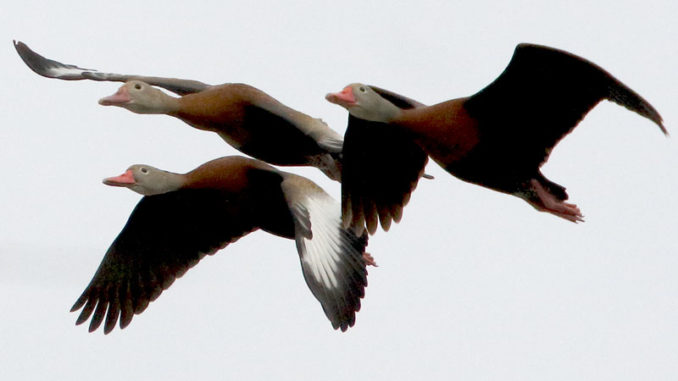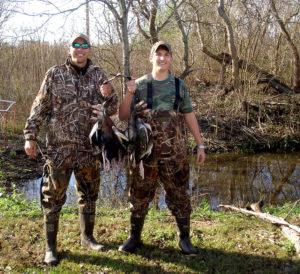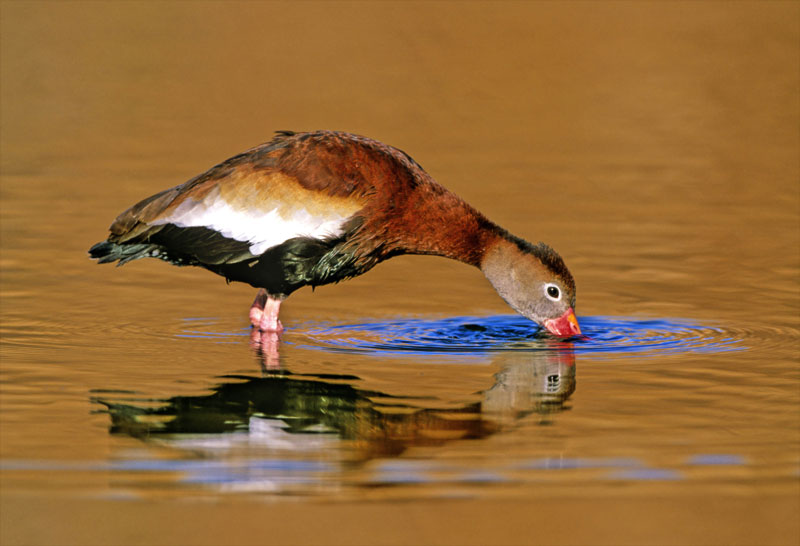
Normally a south-of-the-border species, black-bellied whistling ducks are becoming more of a presence in Louisiana marshes. Here are some things to know about this big, tasty bird.
Their distinct cacophony of whistles broke the pre-dawn silence on a steamy September morning in coastal Louisiana. Though not our intended target, the sound nonetheless got us going as a sign of the marsh’s awakening.
With a few notes on the whistle imitating their call, the wad of ducks descended on our decoy spread in its entirety, fluttering over the decoys before setting down gracefully. With a dumbfounded look on the dog’s face, we could only sit and watch as the rowdy crew taunted us during a period when they were off-limits.
With increasing frequency, hunters are reporting sightings of black-bellied whistling ducks, commonly also referred to as “squealers,” during their teal-season outings and beyond. With only limited hard data available, reports of these birds being seen and harvested across the lower half of Louisiana are on the rise, as it appears the birds are spending more time here than previously observed. Similarly, even non-hunters routinely report sightings of these birds in urban settings, rapidly becoming fixtures of neighborhood ponds and parks, among a variety of other locales.
Though more similar to a swan than a duck, these birds are often decoy- and call-friendly and are particularly suitable for table fare, making them a popular target when opportunities present afield. Paul Link, a waterfowl biologist with the Louisiana Department of Wildlife and Fisheries who has as much or more experience studying the birds than anyone else in the region, acknowledges that, indeed, accounts of increasing abundance across the lower portion of the Bayou State are growing.

What we don’t know
“Black-bellies are amazing birds for our area, but there’s just so much we don’t know about them,” Link said. “They’re very difficult to survey due to their propensity to use such a variety of habitats; that makes counting them a real challenge.”
Despite having banded thousands of the birds, Link said that the number of encounters with those bands through hunter harvest and reporting is extremely low, making data collection very difficult compared to other species.
“We only see an encounter rate of 2% to 3% for black-bellies, whereas other species might see rates from 15% to 25%,” Link said.
As a result, traditional means of data collection for the species is drastically reduced, making traditional management strategies for waterfowl difficult to apply.
Though previously a mainstay south of the border, input from Link’s colleagues in Mexico and beyond indicates that habitat displacement from their historic range may have led birds to spend more time in Louisiana, seemingly adapting well to the variety of habitats. According to Link, they are incredibly nomadic and very adaptable, nesting on the ground or in tree cavities. Reports of them taking well to wood duck boxes are also on the rise.
Link also notes how the bird’s opportunistic feeding habits have drawn them to our agriculture lands, but also our golf courses just the same.
“It’s incredible as to what these birds will eat — just about anything they can fit in their mouth,” he said. “They love Bermuda (grass) seeds at our golf courses or rice in our fields, but (they) will gladly set up shop at a backyard bird feeder,” noting that they are quick to gorge on about any type of grain available.
Heard, but not seen
However, despite observations of these birds being reportedly on the rise, many hunters insist that they’re not necessarily having proportionately higher success in harvesting them. Link’s observations of these wily birds may provide some key insight.

“These are very smart birds, with complex vocalizations and the ability to share information,” he said. “On top of that, they are very well-adapted to nocturnal behavior, doing much of their moving around and feeding at night.”
Link pointed out that black-bellies are equipped with additional rods in their eyes, thus are naturally well-suited to nocturnal movement. This would lend some credence to observations from many who have commonly seen or heard often-noisy groups before shooting time, only to have them disappear shortly thereafter.
Also, their affinity for urban areas is contributing to their reduced likelihood of encountering hunters.
City slickers
“In 2016, 17 of my 20 birds equipped with transmitters converged in metro New Orleans from points dispersed all over south Louisiana,” Link said. “One additional bird spent its days within a refuge and only left to feed elsewhere at night.”
Within the city, birds were observed feeding in a variety of places, from parks to even a rail terminal, thus all but guaranteeing they would not encounter hunters hiding in the marshes just a few miles outside of town.
Despite their affinity for being in town, plenty of black-bellies are encountered in marshes and agricultural fields, but upping your odds of bagging the unique birds may take some specific efforts. For example, putting in the time to locate their preferred habitats is the best bet for success, though it may result in fewer chances at other waterfowl.
“These are birds you really have to watch from a distance and observe their patterns; you can’t go running in with a boat and disturb them,” Link said. “They can surely humble you, as they can be very difficult to hunt, and it requires patience to key in on their patterns and preferred flight paths.”

Give ‘em a whistle
Many hunters have found black-bellies to be quite responsive to whistling calls run to mimic the cadence of the birds’ calls. Not sure what they sound like? Just listen as they approach, as they’re not known to be a quiet species. If a flight is passing by within calling distance, you’ll know about it, and mimicking their sounds with any number of whistling calls is usually quite effective.
My go-to is the MP-90 from Haydel’s Game Calls, which has put its share of squealers and other whistling species on the strap over the years. Haydel’s has also introduced another whistling call tuned to mimic both the black-belly and fulvous whistling ducks, the W-19. In either case, replicating the cadence you hear from the approaching birds will usually bring them by for a closer look.
Similarly, decoys specific to the species are not something to sweat when hoping for a pass within range. Not only are such decoys not commercially produced, but squealers are just as apt to approach very close with no decoys whatsoever as with a large spread of the usual species in an area. Instead, putting your focus into thoroughly hiding and accurately imitating their calls are likely to be the two main keys to an opportunity for harvest.
If and when you are successful in strapping a few of these birds, up to six per person per day during our regular November-to-January waterfowl season, the real value of the species will show up on the dinner plate. Offering a milder breast meat than many species, squealers are a great fit for just about any of your favorite preparation methods.
With a little shift in the mindset, black-bellied whistling ducks can bring a new twist to the Louisiana waterfowl seasons. Though they can be a challenge to target, they’re propensity to be particularly vocal makes calling them a lot of fun and harvest that much more rewarding. Keep an ear out for these birds and be prepared with whistle at hand; they’ll be great additions to your favorite waterfowl recipes.

Black-bellies not likely to be added for early season?
Larry Reynolds, the waterfowl study leader for the Louisiana Department of Wildlife and Fisheries, said that while plenty of black-bellied whistling ducks are showing up in the Bayou State during the popular September teal season, federal game managers are unlikely to allow them to be taken then.
“Since the 2013 ‘Assessment of the Harvest Potential of North American Teal,’ which provided justification to increase the bag limit during the September teal season from four to six and allow additional states to participate in those seasons, the U.S. Fish and Wildlife Service has consistently held that they will not consider additional species in that season’s bag limit,” he said. “Additionally, they have specifically cautioned against allowing a ‘big duck’ in the teal season bag in Louisiana and Texas out of concern for the declining status of mottled ducks. As a result, that’s forced us to consider an additional early season targeting only whistling ducks.
“Regardless of how we frame it, we’ll need to provide justification for such a request in the form of estimates of population size, survival rates, harvest rates, and potential impacts to non-target species which is going to be challenging,” he said. “A large portion of black-bellied whistling ducks use urban or suburban habitats for much of the year and are difficult to survey over their range. Paul (Lynk) and our field staff have done a great job of expanding the banded sample of black-bellied whistling ducks, but with so relatively few recoveries, we are struggling to get a handle on survival and harvest estimates.
“We know even less about fulvous whistling ducks, and it would be impractical to have a black-bellied whistling duck season or add them to the teal season bag limit without also including fulvous whistling ducks. Lastly, any special season or addition to teal season bag limits would also require evaluation in the form of ‘hunter performance surveys’ aka ‘spy blind studies.’ The benefits of additional hunting opportunity for whistling ducks has to be weighed against the resources needed to justify and evaluate that opportunity, and the waterfowl section is continuing to work toward providing those benefits.”
